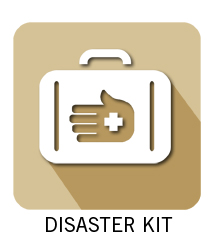Disaster Kit
When preparing for a possible emergency situation, it’s best to think first about the basics of survival: fresh water, food, clean air, and warmth.
After a major disaster, the usual services we take for granted, such as running water, refrigeration, and telephones, may be unavailable. Experts recommend that you should be prepared to be self-reliant for at least three days. Store your household disaster kit in an easily accessible location. Put contents in a large, watertight container (e.g. a large plastic garbage can with a lid and wheels) that you can move easily.
Your basic emergency kit should include:
- Water – One gallon per person per day
- Food – Ready to eat or requiring minimal water
- Manual can opener and other cooking supplies
- Plates, utensils, and other feeding supplies
- First Aid kit and instructions
- A copy of important documents and phone numbers
- Battery-powered or hand crank radio and a NOAA Weather Radio with tone alert and extra batteries for both.
- Warm clothes and rain gear for each family member
- Heavy work gloves
- Disposable camera
- Unscented liquid household bleach and an eyedropper for water purification
- Personal hygiene items including toilet paper, feminine supplies, hand sanitizer, and soap
- Plastic sheeting, duct tape, and utility knife for covering broken windows
- Tools such as a crowbar, hammer & nails, staple gun, adjustable wrench, and bungee cords
- Blanket or sleeping bag
- Large, heavy-duty plastic bags and a plastic bucket for waste and sanitation
- Any special-needs items for children, seniors or people with disabilities. Don’t forget water and supplies for your pets.
- A component of your disaster kit is your Go Bag.




